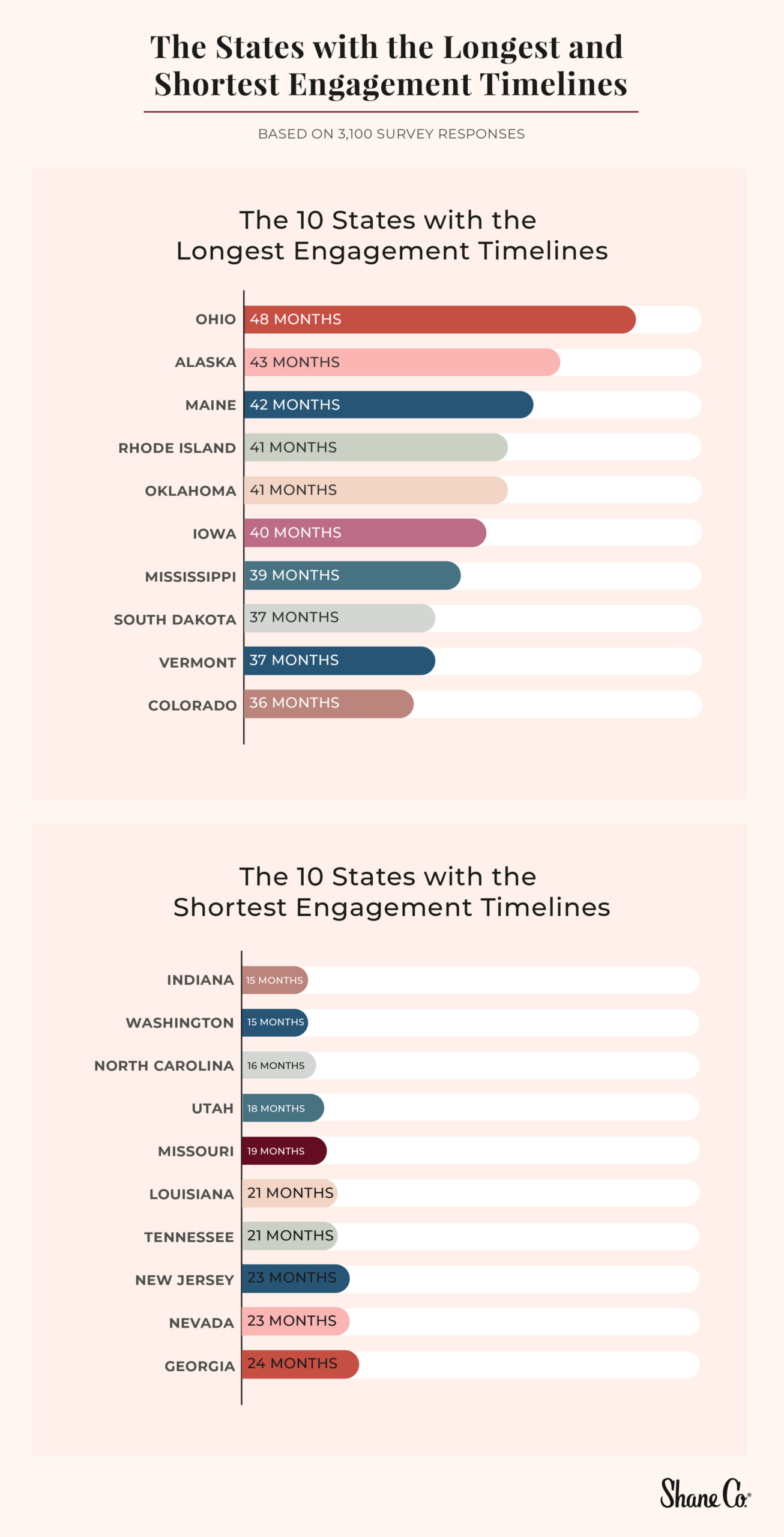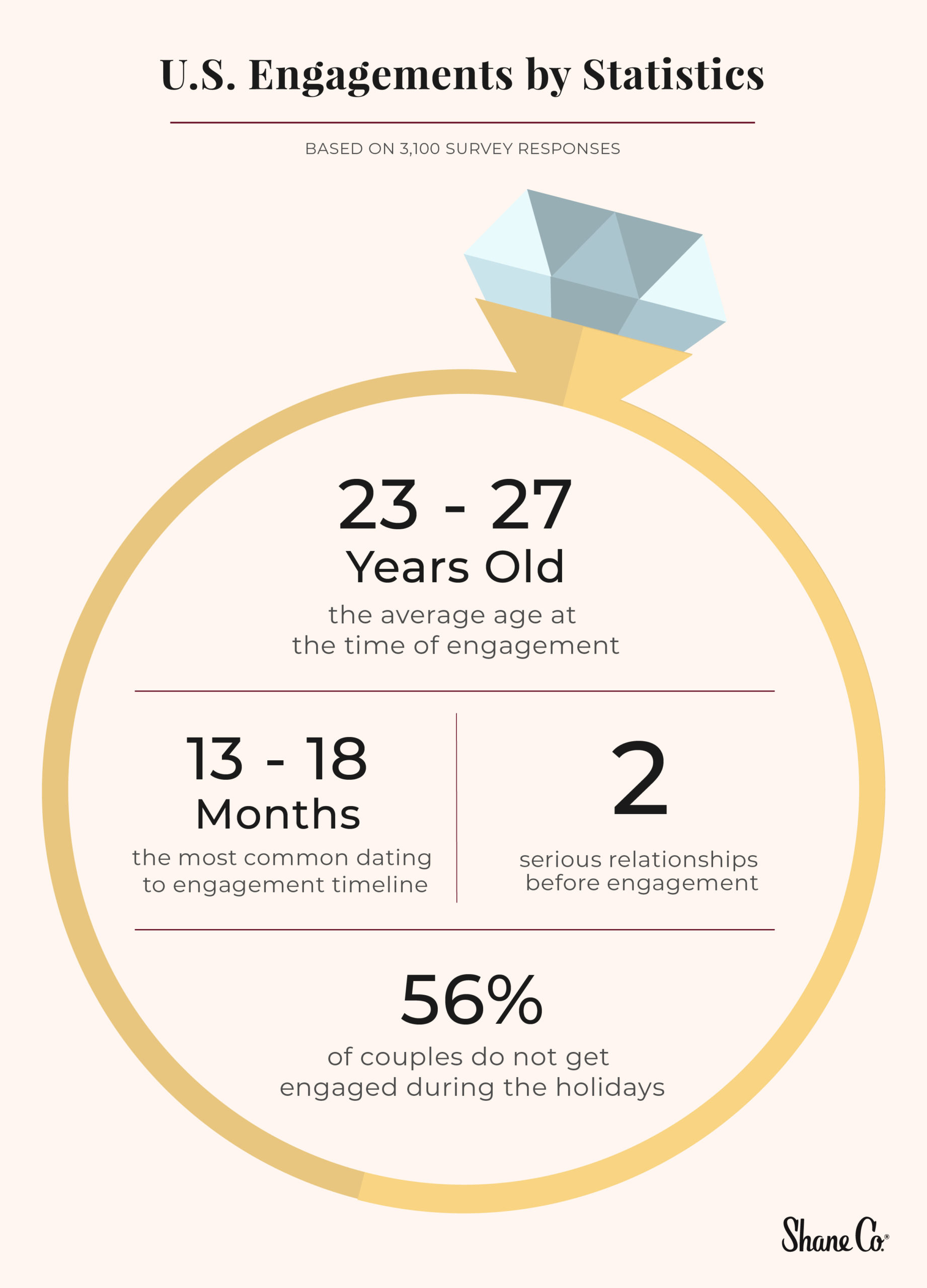
Whether snow fell during the holidays or not, there is always a flurry of proposals during the festive months. Generally lasting from Thanksgiving through Valentine’s Day, “engagement season” seduces more couples to affiance than any other time of year. At Shane Co., we totally get the impulse to drop to one knee and proclaim your love with a beautiful diamond amid family, friends, and festive cheer.
The holidays have a lot going for them. There’s an abundance of joy, inescapable mistletoe, that extra glass of wine, and loved ones all gathered together to share in your tender moment. Still swooning over how many engagements we’ve helped with so far this season, we decided to learn all about engagements in the United States.
We wanted to know how long people date before getting engaged, what the average engagement looks like, and what, if any, external factors contributed to the decision to propose (or to say “yes!”). Not willing to leave these important matters to speculation, we surveyed 3,100 engaged or married couples across the U.S., including at least 50 respondents from each state.
Read on to see what we found!

We started where it all begins and asked respondents how many months had elapsed between their meet-cutes and engagements. We discovered that, on average, couples date for about 30 months or just over 2.5 years before engaging! But the national average doesn’t speak for each state individually, and that’s where the results really surprised us.
Ohioans are the slowest to get engaged, not popping the question until after a whopping 47.5 months of diligent dating. If you find yourself star-crossed with an Ohioan, you’ll have that many more romantic evenings on the shores of beautiful Lake Erie. On the opposite end of the engagement timeline spectrum sits Indiana. There must be a strong love potion in the waters of Lake Michigan, because Hoosiers are ready to commit to be betrothed after a brisk 15 months!
Expanding beyond the humble Midwest, we charted the 10 longest and shortest engagement timelines.
See if your state makes either list in the graphic below!

But knowing where engagements take the longest is only one piece in the mosaic of love. Our next logical step was to take a deep dive into the average American engagement to find out more about the people who are locking into lifelong commitments.
Of course, engagements come in all shapes and sizes. Some are over the top, some are private, some come from seasoned romantics, and others are the product of high school love. Nevertheless, we couldn’t resist trying to map out the most common formula for engagements by the numbers, from the average age to the average number of past relationships.

Our deep dive into the average American engagement revealed that the average engaged couple is 23 to 27 years old and has been dating for an average of 13 to 18 months. The highest percentage of respondents also had two previous relationships lasting six months or longer, so they’re not total strangers to the game of love. This suggests they’ve had substantial interest in finding long-term commitment in the past.
As for when engagements typically happen, 56% of respondents did not pop the question during the holiday season, while a whopping 44% did! So, are these magical moments as pure as the snowfall on Christmas Eve, or have they been affected by outside pressures from well-meaning family, society, and more?

Pressure from family and friends affected the engagement timelines of nearly 36% of respondents. Parents were the guiltiest party, responsible for putting pressure on 22% of respondents to engage. On the other hand, grandparents, siblings, and friends largely stayed out of the matter.
Respondents felt even more pressure from society, with more than 40% either agreeing or strongly agreeing that it contributed to their engagement timeline. This makes sense, considering how much pressure society puts on us to fit in and be successful in life, love, and relationships. Pressure to marry by a certain age and seeing friends getting engaged first were the top two pressures levied by society.
While men felt less pressure from society than women did, we think that pressure trickled down to them vicariously through their partners. A shocking 52% of men were pressured to get engaged by their romantic partner, compared to just 34% of women.
Finally, while 44% of respondents got engaged during the holidays, only 35% claimed that seasonal pressure contributed to their timeline.
Overall, we discovered that it can be easy to fall victim to pressures brought on by society, family, and the holidays. But it’s important to remember that committing to another person for the rest of your life is one of the most important decisions you can make and should never be influenced by anyone other than yourself and your partner.
So, whether you get engaged after six months or six years, make this important commitment only when YOU feel comfortable. And when you’re ready, Shane Co. is here to help you pick out an engagement ring that you’ll treasure forever.


